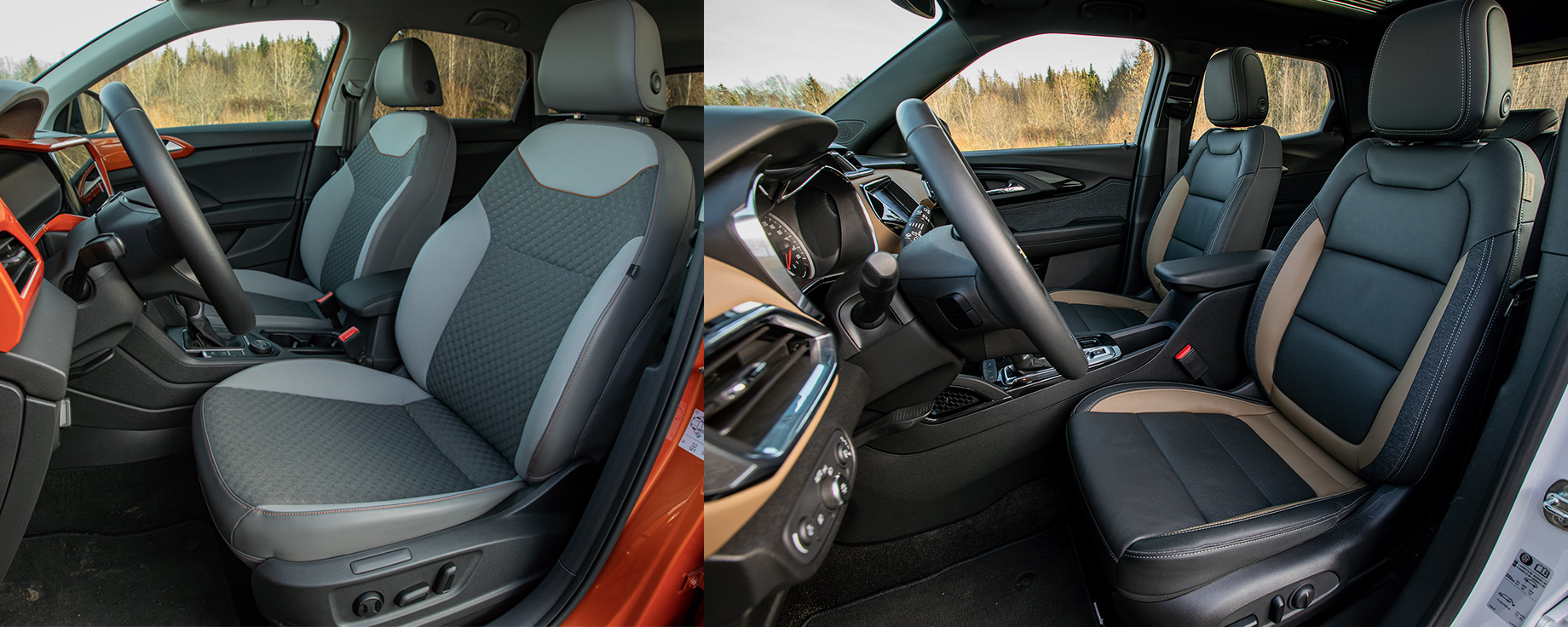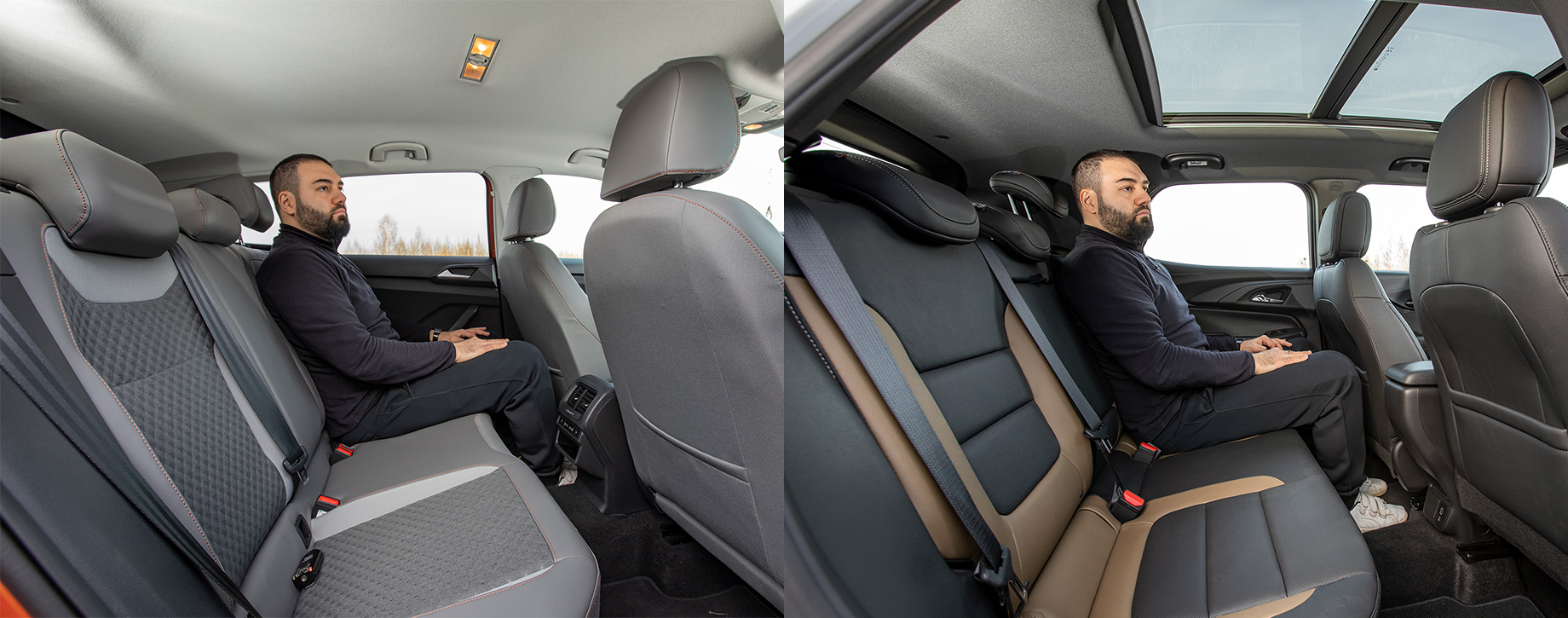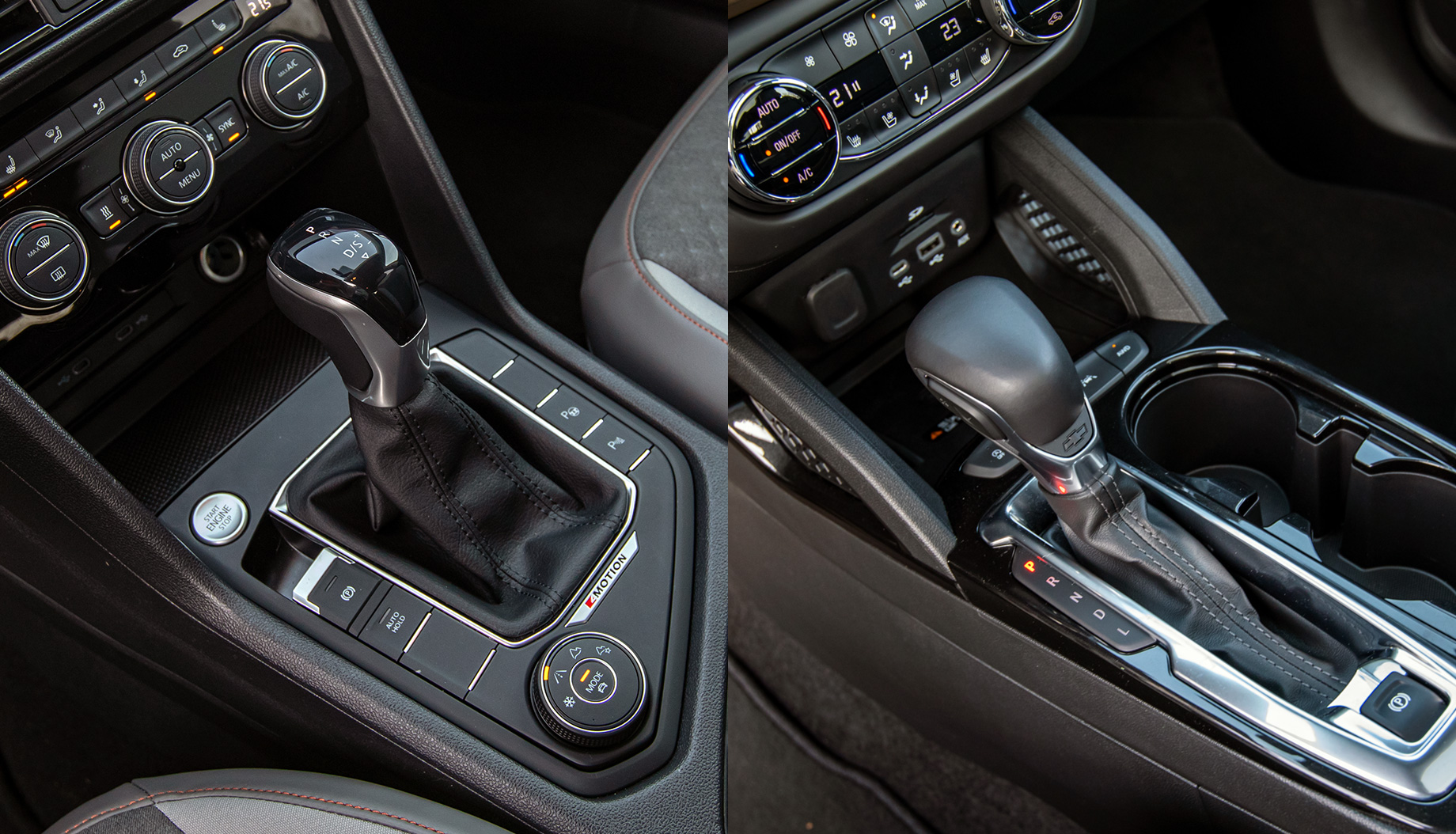Volkswagen Taos vs Chevrolet Trailblazer: which of the competitors wins?
Let us present to you the true direct competitors. These brothers in the B+ crossover segment almost have the same length of body and wheelbase. Gasoline turbo engines reach 150 hp each. Let’s take a closer look at the models.
The Taos is larger than the Karoq based on the same platform but more compact than the Tiguan. Like related crossovers, it looks modest. The orange body color is its most prominent feature. One can linger even longer on the white Trailblazer. It is taller than the Taos that is disguised as a raised hatchback, and looks like a real SUV in a plastic body kit with bumper protectors.

In addition, its appearance differs depending on the design variant. We have a pseudo-offroader Activ option, and a pseudo-sport RS one can be supplemented with a beautiful blue body, Cayman. Even if you refuse the contrasting roof, black inserts will still remain on the rear pillars. They add elegance to the transition from the side panels to the relief rear door.
Both crossovers have narrow sills completely covered with doors, although weatherstrips still leak dirt during off-road outings. The Taos’s sill is lower, which makes it easier to get into the car. The Chevy’s front door opening is taller and wider, but some drivers still bump their heads against the front pillar when getting behind the wheel.
As for the Volkswagen, you rather fall into its driver’s seat – there is a passenger car seat type. With a seat lowered, a 5’11” driver won’t see the hood, and the window rail will be located higher than in the Chevrolet. The steering wheel adjustment range is greater in all directions. So you can sit further away and stretch your legs even more. There is a lot of space above your head – you can even sit in a top hat.
The Trailblazer’s ceiling is closer, but there is enough space in general. What’s worse is that the seat geometry is more tied up in the adjustment of the steering column. It lacks the range of a steering column reach. That’s why you sit closer to the steering wheel, bending your knees even more. It’s a shame, because the seat moves even further in the longitudinal direction than in the Taos.

If you don’t race an engine in turns, there are no complaints about the seats in fact. The cushion has a enough length; the back bolster is optimally positioned and adjustable in a wide range, and the seatback perfectly distributes the pressure. The Taos’s fabric-covered seat is softer and therefore more comfortable. It holds your body better, but the support in the shoulder blades zone is worse.
Trim materials in the compact Volkswagen are modest, but the interior is well-assembled and ergonomic. The climate control unit is push-button, not touch-sensitive, as, for example, in the Tiguan, and, unlike in the latter, its central armrest doesn’t prevent you from using either the gearbox, the tunnel buttons, or the rotary drive selector. But there are some points here. When you release the pressed steering lever after a single sweep of the wipers, it springs back so that it skips to the next fixed position, enabling interval wiping.
The Chevrolet’s interior design is more interesting, but the materials chosen are so-so. There’s such a hodgepodge of textures here! There are several types of black plastic alone, including matte ones of varying shine degrees, rubberized and glossy with a piano lacquer coating. There are also fabric door elements and a soft brown veneer with a stitch on the front panel. In fact, the materials are more expensive than in the Volkswagen, but this mish-mash…
And the main problem of the Trailblazer is its nonadjustable central armrest. It’s installed in such a way that it constantly prevents a driver from turning the steering wheel to the right with ease. On the way down, the right elbow 99% bumps into the lid of the box between the seats, unless you pin your arm to your side on purpose. But driving like this is not just uncomfortable, but often dangerous.
Vision is also obscured. Any large-sized equipment can fit behind the thick front pillars. The rear ones are too massive. The glass has been cut down for the sake of style – it is more difficult to reverse out of a parking lot than in the Volkswagen. Only side mirrors of the Taos are inferior in size.

Second-row passengers will enjoy sitting in the Volkswagen more. It provides more space in the knee zone and above the head, although the feet are equally comfortable in both cars. The distance between the ceiling and the top of a head is three times greater than in the Trailblazer. It’s also more convenient to install child seats here, thanks to easy access to the fasteners under plastic plugs.
In the Chevrolet, the Isofix brackets are clamped between the backrest and the pillow, which is why the installation of a child seat or booster chair takes longer. But it is more convenient to place a baby carrier in the Trailblazer, as well as to take a seat on the second row yourself. The rear openings are higher and wider, so it is easier to evade a wheel arch. It is also more convenient to be a third passenger here: despite the fact that the cabin is a little narrower, the tunnel is lower and nothing prevents you from putting your feet on it. A massive box between the Taos’s front seats doesn’t allow you to do this.
Our crossovers don’t offer an electric massager, but the Trailblazer’s three-cylinder turbo engine perfectly performs this function. Vibrations are felt in abundance on the seats and steering wheel. The engine noise is also noticeable. But it’s powerful! The Chevrolet’s engine, which has no alternative, produces 236 N-m from 1600 rpm to 4000 which is good for its volume. There is always a thrust reserve under the gas pedal – for both urban and countryside driving.
On summer tires and with a traction control off, the Chevrolet goes zero to 60 in 9.9 seconds on the first attempt. That’s great – the manufacturer promises 10.5 seconds. A few more starts and another 0.1 second is won back. It is the limit modes that are best performed by the Trailblazer. It starts vigorously, powerfully catches up almost in the entire revolution range. Even the automatic transmission, during pedal to the metal accelerating, discards slowness, quickly changing nine finely tapped steps.
But acceleration “to the floor” alone can’t satisfy the needs of buyers. Extremes are rare in everyday life. It is more important what it’s like to be stuck in traffic jams with the Trailblazer or to drive in the normal mode. And there are problems here. You can’t choose driving modes, and the basic setting of the power unit is too sharp. In order to gently dose traction in traffic jams, you need to go too deeply into the process, distracting yourself from the road. And while you are looking for an approach to the car, passengers complain about jerks.

When city traffic clears and the accelerator connection is leveled, the gearbox gets all weird. If you give it time to think, it becomes slow and the change of ranges – poorly predictable. In the same situation, the automatic transmission can quickly change down through one or two gears or continue running in the current one. But everything is unambiguous when it’s necessary to change down through three or even four gears – in the sense that it always takes an excruciatingly long time. We mean, it always takes an excruciatingly long time. And the GM gearbox likes to choose higher gears, even in the city.
The Volkswagen’s DSG DQ381 semi-automatic transmission doesn’t shrink from fuel economy either, which shifts to the highest seventh gear up to 80 km/h in standard mode. At the same time, the Taos responds to the gas pedal as indifferently as possible. Nothing will happen until you pass a third of the pedal travel. You can only drive in traffic jams with such a calibration. There, your drowsiness benefits – the fuel supply is delicate, the acceleration is smooth.
In other cases, we wouldn’t switch to Sport. That’s how the potential of the 1.4 TSI engine with 250 N-m at 1500 rpm is fully realized. This is the only way to get appropriate traction control with quick reactions to the accelerator and timely DSG switches. And this is the only way Launch Control can reproduce the manufacturer’s certificate standard of 8.9 s at acceleration up to 100 km/h. The Volkswagen is also faster than the Trailblazer at the start with a foot moving on the pedal – 10 seconds vs 10.6.
The Volkswagen’s chassis balance is close to exemplary. The steering wheel is vibrant, the brakes are precise and efficient, and the suspension would easily serve as a workpiece for a hot hatch. Responsiveness, concentration, playfulness in turns make you rejoice like a child. At the same time, the Germans maintained a good smooth ride on a hard surface. The crossover is indifferent to the micro-profile of the roadway, deals with medium-sized bumps without problems, and isn’t stressed on the road with sloppy mends. But it’s better to go around deep pits in order to avoid impacts and slow down to 12 mph in front of the “speed bumps”.
The Trailblazer reacts more acutely to potholes of any size and shakes passengers from side to side even more. The main thing is that its ride is poor. It seems like you are driving on a smooth road, but vibrations in the cabin are mixed with itching from rough asphalt. An “uproar” from the wheels doesn’t add gloss; the engine is also “vociferous”. Handling is frustrating: rolls are more intense, and the steering wheel, confused by background force, hardly counts as a reliable communication channel.
The Trailblazer is partially rehabilitated off-road. You can race on a broken earth road at a higher speed, more comfortably, and with fewer holes on the car’s body. The all-wheel-drive transmission works better. It has no off-road modes. It is impossible to forcibly lock the clutch here, but the electronics transmit the torque to appropriate wheels faster with a diagonal suspension. The Chevrolet also rides more confidently on a washed-out uphill road.

The Taos is also able to overmaster a muddy road section, but you need to turn on off-road mode for a relatively seamless overcoming. And, as in the case of the Tiguan from our other test drive, a separate off-road program helps out a lot when axling wheels. However, episodic achievements don’t allow us to forget about the 2 cm less road clearance, the worst geometric passing ability and worthless ride comfort on a bumpy earth road.
If you often have such outings, it is better to choose the Trailblazer with its metal protection under the power unit. Or if you like the Chevrolet’s design more. This is also an argument. But in other cases, the crossover with a cross on the radiator grille is not a match for the Taos. It seems like the car was developed in a hurry: the designers did their best, but fine driving settings were neglected. A combination of low-budget sensations and a high price is the Trailblazer’s cross.
The Volkswagen also doesn’t impress with its trim materials. And it is also not cheap with its supercharged engine, but it is still cheaper with similar equipment. In addition, it is faster, more spacious, convenient for everyone in the cabin, equally attentive to the wishes of comfort lovers and fans of good steering. However, the Taos will compete on the market not with the Trailblazer, but rather with the co-platform Karoq. On the one hand, the latter is cheaper with comparable consumer properties. On the other hand, let’s remember that the Polo sells better than the Rapid, the Tiguan is ahead of the Kodiaq. We anticipate the same situation in the Taos-Karoq pair.
This is a translation. You can read the original here: https://www.drive.ru/test-drive/chevrolet/volkswagen/61a8f7379bf2ef1fc46f8e5a.html






